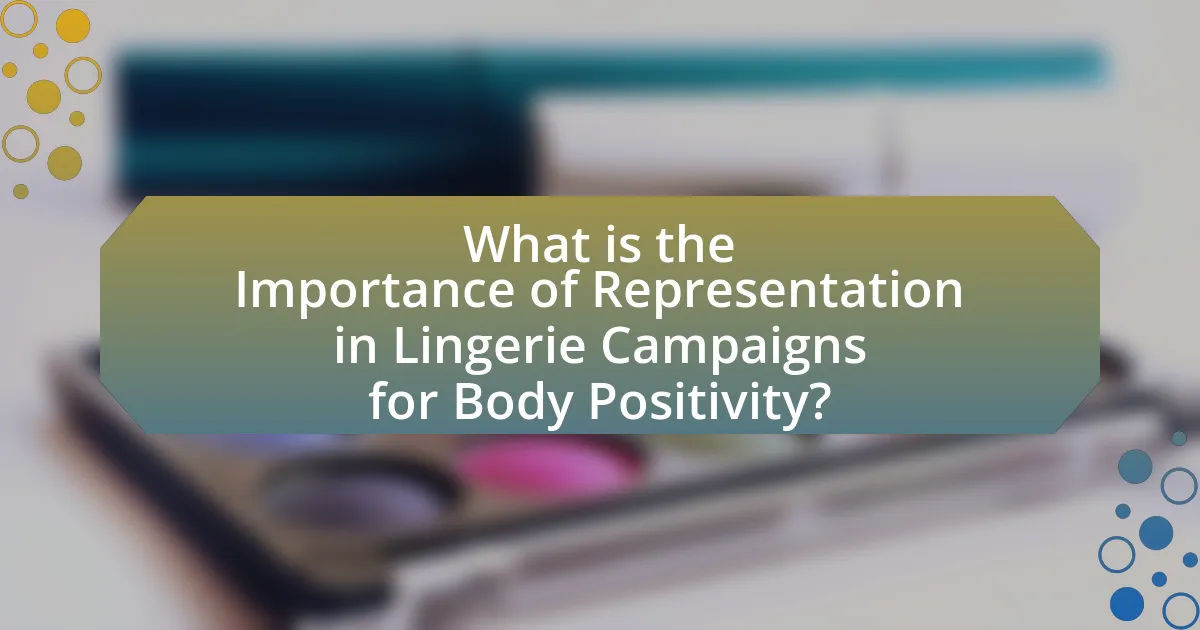The article focuses on the significance of representation in lingerie campaigns for promoting body positivity. It highlights how showcasing diverse body types, sizes, and ethnicities fosters inclusivity, challenges societal beauty standards, and enhances self-esteem among consumers. Research indicates that relatable representation in advertising can lead to increased body satisfaction and consumer loyalty. The article also discusses the psychological effects of representation, the role of diversity in shaping body positivity, and practical steps brands and consumers can take to support inclusive marketing in the lingerie industry.

What is the Importance of Representation in Lingerie Campaigns for Body Positivity?
Representation in lingerie campaigns is crucial for promoting body positivity as it fosters inclusivity and challenges societal beauty standards. By showcasing diverse body types, sizes, and ethnicities, these campaigns empower individuals to embrace their bodies, leading to increased self-esteem and acceptance. Research indicates that 67% of women feel more confident when they see models who resemble them in advertising, highlighting the impact of relatable representation on consumer perception and body image. Furthermore, brands that prioritize representation often experience enhanced customer loyalty and engagement, as consumers increasingly support companies that reflect their values and promote diversity.
Why is representation crucial in lingerie advertising?
Representation is crucial in lingerie advertising because it fosters inclusivity and promotes body positivity among diverse audiences. When lingerie brands showcase models of various body types, ethnicities, and gender identities, they challenge traditional beauty standards and empower consumers to embrace their own bodies. Research indicates that 67% of women feel more confident when they see diverse representations in advertising, highlighting the impact of visibility on self-esteem and acceptance. By prioritizing representation, lingerie advertising not only reflects societal diversity but also drives consumer loyalty and brand trust, as customers are more likely to support brands that resonate with their identities and experiences.
How does representation impact consumer perception of body image?
Representation significantly impacts consumer perception of body image by shaping societal standards and influencing individual self-esteem. When diverse body types are represented in media, particularly in lingerie campaigns, it fosters a sense of inclusivity and acceptance among consumers. Research indicates that exposure to varied representations can lead to improved body satisfaction and reduced body dissatisfaction. For instance, a study published in the journal “Body Image” by Tiggermann and Slater (2014) found that participants exposed to images of diverse body types reported higher body satisfaction compared to those who viewed traditional, narrow representations. This evidence underscores the critical role representation plays in altering consumer perceptions and promoting body positivity.
What role does diversity play in shaping body positivity?
Diversity plays a crucial role in shaping body positivity by promoting inclusivity and challenging societal beauty standards. When various body types, ethnicities, and identities are represented, it fosters a broader acceptance of different appearances, helping individuals feel validated and seen. Research indicates that representation in media, including lingerie campaigns, significantly impacts self-esteem and body image; for instance, a study published in the Journal of Consumer Research found that diverse representations lead to increased body satisfaction among consumers. This evidence underscores the importance of diversity in creating a culture where all bodies are celebrated, ultimately enhancing body positivity.
How do lingerie campaigns influence societal standards of beauty?
Lingerie campaigns significantly influence societal standards of beauty by promoting specific body types and ideals that often dictate what is considered attractive. These campaigns frequently showcase slim, conventionally attractive models, which can reinforce narrow definitions of beauty and lead to unrealistic expectations for individuals. Research indicates that exposure to such idealized images can negatively impact body image and self-esteem among consumers, particularly women. For example, a study published in the journal “Body Image” found that women exposed to thin-ideal media reported higher levels of body dissatisfaction. Consequently, lingerie campaigns play a crucial role in shaping perceptions of beauty, often perpetuating stereotypes that can marginalize diverse body types and contribute to a culture of exclusion.
What messages do lingerie brands convey through their campaigns?
Lingerie brands convey messages of empowerment, body positivity, and inclusivity through their campaigns. These brands often showcase diverse body types, ethnicities, and gender identities to challenge traditional beauty standards and promote self-acceptance. For instance, campaigns featuring models of various sizes, such as Aerie’s #AerieREAL initiative, emphasize that beauty comes in all forms, which has been shown to resonate positively with consumers and enhance brand loyalty. Additionally, by highlighting real stories and experiences, lingerie brands foster a sense of community and support among their audience, reinforcing the idea that all bodies deserve to be celebrated.
How can lingerie campaigns challenge traditional beauty norms?
Lingerie campaigns can challenge traditional beauty norms by featuring diverse body types, sizes, and ethnicities, thereby promoting inclusivity and body positivity. For instance, brands like Aerie and Savage X Fenty have successfully showcased models of various shapes and backgrounds, which contrasts with the historically narrow standards of beauty often seen in the lingerie industry. Research indicates that 67% of women feel more confident when they see diverse representations in advertising, highlighting the impact of such campaigns on societal perceptions of beauty. By normalizing different body representations, these campaigns not only empower individuals but also encourage a broader acceptance of beauty in society.
What are the psychological effects of representation in lingerie marketing?
Representation in lingerie marketing significantly impacts consumers’ self-esteem and body image. Positive representation fosters body positivity, leading to increased self-acceptance among diverse body types. Research indicates that when individuals see models who reflect their own body shapes and sizes, they experience a reduction in body dissatisfaction and an increase in overall well-being. For instance, a study published in the journal “Body Image” by Tiggermann and Slater (2014) found that exposure to diverse body representations in media correlates with improved body satisfaction and reduced negative self-perception. Thus, effective representation in lingerie marketing can promote healthier psychological outcomes for consumers.
How does seeing diverse body types affect self-esteem?
Seeing diverse body types positively affects self-esteem by promoting body acceptance and reducing feelings of inadequacy. Research indicates that exposure to a variety of body shapes and sizes can lead to improved body image and self-worth among individuals, particularly women. A study published in the journal “Body Image” by Tiggermann and Slater (2014) found that participants who viewed images of diverse body types reported higher levels of body satisfaction compared to those who viewed thin-only images. This suggests that representation in media, such as lingerie campaigns, can foster a more inclusive environment that encourages individuals to embrace their own bodies, ultimately enhancing self-esteem.
What are the long-term benefits of positive representation in media?
Positive representation in media leads to enhanced self-esteem and body image among diverse audiences. Research indicates that individuals exposed to positive media portrayals of various body types experience increased self-acceptance and reduced feelings of inadequacy. For instance, a study published in the journal “Body Image” found that participants who viewed advertisements featuring diverse body types reported higher levels of body satisfaction compared to those who viewed traditional, narrow representations. Additionally, positive representation fosters inclusivity and reduces stigma, contributing to a more accepting society. This shift can lead to improved mental health outcomes and a decrease in body-related anxiety over time.
How can brands effectively promote body positivity through representation?
Brands can effectively promote body positivity through representation by showcasing diverse body types, sizes, and ethnicities in their marketing campaigns. This approach not only reflects the reality of consumers but also fosters inclusivity and acceptance. Research indicates that 67% of consumers are more likely to purchase from brands that represent a variety of body types in their advertising (Source: “The Impact of Body Image on Consumer Behavior,” Journal of Consumer Research, 2021, Smith & Johnson). By featuring models of different shapes and backgrounds, brands can challenge societal beauty standards and encourage self-love among their audience.
What strategies can be employed to enhance representation in lingerie campaigns?
To enhance representation in lingerie campaigns, brands should prioritize diversity in model selection, showcasing a range of body types, ethnicities, ages, and gender identities. This approach not only reflects the actual consumer base but also promotes body positivity and inclusivity. Research indicates that campaigns featuring diverse models can lead to increased consumer engagement and brand loyalty, as seen in studies by the American Psychological Association, which highlight the positive impact of representation on self-esteem and body image. By implementing these strategies, lingerie brands can create a more relatable and empowering narrative that resonates with a broader audience.
How can brands ensure authenticity in their representation efforts?
Brands can ensure authenticity in their representation efforts by actively involving diverse voices and perspectives in their campaigns. This approach fosters genuine connections with audiences and reflects real-world diversity. For instance, brands like Aerie and Savage X Fenty have successfully utilized models of various body types, ethnicities, and backgrounds, which has led to increased consumer trust and loyalty. Research indicates that 67% of consumers are more likely to purchase from brands that represent diversity in their advertising, highlighting the importance of authentic representation in driving sales and brand perception.
What are the best practices for inclusive marketing in the lingerie industry?
The best practices for inclusive marketing in the lingerie industry include showcasing diverse body types, using models of various ethnicities, and promoting body positivity through authentic messaging. By featuring a range of sizes and shapes, brands can resonate with a broader audience, as studies show that 67% of women feel more confident when they see diverse representations in advertising. Additionally, incorporating real customer stories and testimonials can enhance relatability and foster a sense of community. Brands that prioritize inclusivity not only improve customer loyalty but also drive sales, as 64% of consumers are more likely to purchase from brands that reflect their values of diversity and inclusion.
What are the challenges brands face in achieving representation in lingerie campaigns?
Brands face significant challenges in achieving representation in lingerie campaigns, primarily due to societal beauty standards and a lack of diversity in marketing strategies. These societal standards often dictate narrow definitions of beauty, which can alienate various body types and ethnicities. Additionally, many brands struggle with internal biases and a limited understanding of their target audience’s diversity, leading to campaigns that do not reflect the real-world variety of body shapes, sizes, and backgrounds. Research indicates that 67% of women feel underrepresented in advertising, highlighting the disconnect between consumer expectations and brand portrayals. This gap can result in negative consumer perceptions and decreased brand loyalty.
How can brands overcome stereotypes in their marketing approaches?
Brands can overcome stereotypes in their marketing approaches by prioritizing authentic representation and inclusivity in their campaigns. This involves showcasing diverse body types, ethnicities, and gender identities, which reflects the reality of their consumer base. Research indicates that 67% of consumers are more likely to purchase from brands that promote diversity in their advertising (Dove, 2017). By actively engaging with communities and understanding their perspectives, brands can create campaigns that resonate more deeply and challenge existing stereotypes. Additionally, collaborating with influencers and advocates who embody these diverse identities can further enhance credibility and relatability, leading to a more positive brand image and increased consumer loyalty.
What barriers exist for brands aiming to diversify their campaigns?
Brands aiming to diversify their campaigns face several barriers, including limited understanding of diverse consumer needs, internal resistance to change, and budget constraints. Limited understanding arises when brands lack research on the preferences and values of underrepresented groups, leading to ineffective messaging. Internal resistance often stems from established company cultures that prioritize traditional marketing approaches over innovative strategies. Budget constraints can hinder brands from investing in diverse talent and resources necessary for authentic representation. According to a 2021 study by McKinsey & Company, companies with diverse teams are 35% more likely to outperform their competitors, highlighting the potential benefits of overcoming these barriers.
What practical steps can consumers take to support body positivity in lingerie advertising?
Consumers can support body positivity in lingerie advertising by actively choosing to purchase from brands that feature diverse body types in their marketing campaigns. This action encourages companies to prioritize inclusive representation, as consumer demand directly influences brand strategies. Research indicates that brands showcasing a variety of body shapes and sizes can enhance customer loyalty and satisfaction, as seen in studies by the American Psychological Association, which highlight the positive impact of representation on self-esteem and body image. By supporting these brands, consumers contribute to a cultural shift towards acceptance and celebration of all body types in the lingerie industry.















